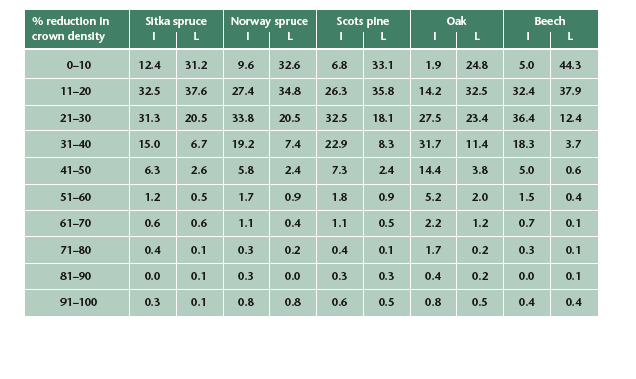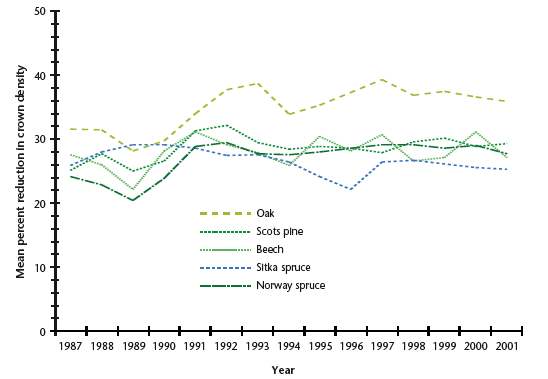The crown density results, using both methods of assessment, are presented in 10% classes in Table 1. The marked effect of using a local reference tree rather than an ideal tree as the basis for comparison can be seen for all species. Much of the difference can be accounted for by variations in growth habit between the reference photographs of ideal trees (Innes, 1990) and the trees in and around the plots to be assessed, from among which a local reference tree is chosen. For example, young trees of all species, but particularly Scots pine, tend to have a more open appearance (i.e. a lower crown density) than the older trees illustrated in Innes (1990), and some older oaks and spruces also have a naturally open structure. For trees like this, the apparent reduction in crown density would therefore be much greater when judged against an ideal tree than when compared to local trees of the same age and form.
Figure 1 shows the changes in crown condition that have taken place since 1987. An upward gradient in this figure indicates a deterioration in crown condition. Changes in crown density compared to last year were minor for all species except beech, the condition of which improved significantly. Analysis of the time series for each species shows that, in general, only relatively large changes in crown density (more than 3% to 4%) between years are statistically significant. Short-term changes of such magnitude, both positive and negative, have characterised beech over the fourteen-year survey period. However, there is no evidence of a long-term deterioration or improvement of crown condition in this species. Similarly, no long-term trends can be detected in the crown densities of either Scots pine or Sitka spruce, although the latter is currently in better condition than at the commencement of the survey in1987. Analysis of the 1987 to 2001 data indicates that a statistically significant deterioration in the crown condition of both oak and Norway spruce has occurred over the duration of the survey. However, the time series is of relatively short duration and the indicated rates of change are small, with an apparent reduction in crown density of 0.47% per annum in oak and 0.37% per annum in Norway spruce. The magnitudes of past increases in crown density in these species suggest that a single year of major improvement in condition could nullify the current trends. In spite of the low rates of change involved, any continued deterioration in the condition of these species would warrant more detailed investigation in order to determine whether such trends were related to long-term changes in specific factors affecting tree condition, such as climatic variables.
Since 1991 the condition scores of Scots pine and Norway spruce have changed less than those of the other species. Although Scots pine deteriorated slightly in 2001 and the condition of Norway spruce showed a minor improvement, neither of these changes was significant. Following a sharp decline in 1997, the condition of Sitka spruce began to improve in 1999 and this recovery continued throughout 2000 and 2001. The crown density of oak also increased this year, its condition having improved in consecutive growing seasons for the first time since 1989. However, it is still markedly poorer than during the late 1980s. The improvement in beech recorded in 2001 completely reversed the deterioration in its condition which occurred in 2000.
Table 1: Percentages of trees in each crown density class for five species in 2001. Each 10% class represents a reduction in crown density compared either to an ‘ideal tree’ (I), i.e. a tree with the maximum possible amount of foliage, or to a ‘local tree’ (L), i.e. a tree with full foliage under local conditions.

Figure 1: Changes in crown density since 1987 for five species surveyed annually. The crown density compared with that of an ‘ideal’ tree with a completely opaque crown is shown for each species.

Figure 2 shows the geographical variation in crown density for the five species assessed. Variation was greatest in oak, which has shown substantially the same pattern since 1997 when data were first presented in this way (Redfern et al., 1998; 1999; 2000). The condition of oak was poorest in central Scotland and north-east England, south-west England, Wales and East Anglia, and best in southern England. Scots pine also displayed a pattern which was similar to that of previous years, with crown density tending to be highest south of the Humber-Mersey line. Beech showed no clear pattern. Both spruces were poorest in the south and east than elsewhere, but this impression is created by relatively few plots and both species show considerable local variation.
The autumn of 2000 was one of the wettest on record, with the highest October rainfall since 1903 being recorded. High levels of precipitation were also recorded over the winter months, and in late February 2001 heavy snowfall occurred in Scotland and northern England resulting in snow-break of branches in many coniferous species, but particularly in Scots pine. A dull April and warm May resulted in a general absence of damaging spring frosts. In spite of hot dry conditions in June and early July no drought damage to forest trees was reported. The remainder of the growing season was generally warm and wet, providing good conditions for tree growth.
The increase in the crown density of beech recorded in 2001 was of sufficient magnitude to reverse the deterioration in condition which the species had displayed in the previous growing season (Figure 1). As noted in previous years (Hendry et al. 2001) poor crown condition in beech is often associated with heavy mast production, whilst crown density is greatest when fruiting is light or absent. Whereas masting was heavy in 2000, little or no fruiting was recorded for 89% of the 1392 beech trees assessed in 2001. However, past deteriorations in the condition of beech associated with heavy masting (e.g. 1990 and 1995) have not been followed by a complete recovery in crown density in the following year in spite of the occurrence of light fruiting. It is therefore likely that some other factor(s) contributed to the large improvement in beech crown density recorded in 2001. Beech is particularly intolerant of water deficit, and the wet weather which prevailed at the end of 2000 and throughout much of 2001 would have provided favourable conditions for its rapid recovery.
Although the condition of oak continues to improve and is now better than at any time since 1995, it remains poorer than any of the other species surveyed. This appears to be due largely to insect damage which was recorded in 73 of the 82 plots assessed this year. Plots with low crown density were generally those in which insect activity was scored as heavy or severe, although wind damage of sufficient extent to affect crown density scores was recorded in five plots. Oak dieback (Gibbs, 1999) was the primary cause of poor condition in three plots in England.
The condition of Sitka spruce improved slightly compared to last year. Although the presence of new damage by green spruce aphid was reported from 24 of the 65 plots assessed, attacks were minor both in terms of the numbers of trees affected and in the degree of defoliation caused. Between 2000 and 2001 the percentage of trees retaining 7 or more needle years rose by 9% to 60.5% suggesting that Sitka spruce is continuing to recover from the severe defoliation which it suffered during the widespread Elatobium outbreak in 1997. In accord with the generally favourable weather conditions there were few reports of climatic damage to Sitka spruce, with frost damage reported from only a single plot. Galls on current year’s shoots caused by the insect Adelges cooleyi were recorded on trees in six plots although the level of damage caused was insufficient to affect crown condition.
A slight deterioration in Scots pine this year reflected both an increase in the incidence of infection by the fungus Lophodermium seditiosum, which was recorded in 16% of surveyed plots, and an increase in the incidence of male flowering which results in non-foliated gaps at the bases of shoots and thus in increased crown transparency. A minor improvement in the crown density of Norway spruce was not associated with a decrease in the incidence or severity of biotic or abiotic damage but may have been due in part to an increase in secondary shoot formation, which was recorded in the majority of trees.
In spite of a relatively short dry period over the country in June and early July, rainfall was well distributed throughout the growing season and tree growth was generally good. Heavy snowfall in February resulted in localised damage to Sitka spruce, Norway spruce and Scots pine in the north of Britain but no other forms of climatic injury were important this year. Changes in crown density were minor in all species except beech, the condition of which improved significantly. However, this change represents a recovery from the sharp decline in the crown condition of beech in 2000 which was associated with heavy mast production and is therefore not necessarily an indication of improving health. Crown density in Norway spruce has displayed only minor fluctuations since 1991 and remained virtually unchanged in 2001. Scots pine deteriorated slightly, largely due to an increase in the incidence of the needle cast fungus Lophodermium seditiosum and heavy male flowering on many trees. A slight improvement in condition this year suggests that Sitka spruce is continuing a gradual recovery from the severe outbreak of Elatobium which affected it in 1997. Oak, although in better in condition than at any time since 1995, still displays a lower crown density than the other surveyed species.